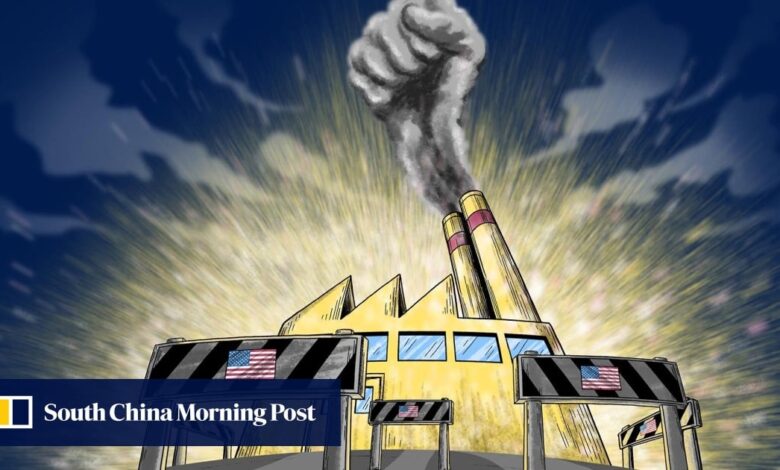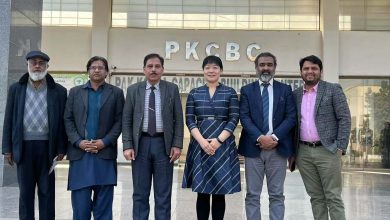How US curbs on China may revive its rust belt – the former industrial powerhouse near Russia

Xi’s trip had come two months after a major shareholder of the robotics giant – the Shenyang Institute of Automation – was added by the US government to its export blacklist.
But even amid Washington’s heightening efforts to block China from the global hi-tech supply chain that supports the production of advanced military equipment, for China’s northeast rust-belt region, the economic opportunities could be on the rise.
“Curbs [from the United States] have inevitably impacted our supply chain, but at the same time it has also offered opportunities to develop our local industrial chain,” Wang Danqun, deputy director of the Liaoning provincial Department of Industrial and Information Technology, said in response to a Post question at a media briefing in September.
As for the “next step”, Wang said: “Liaoning province will focus on doing what the country needs – accelerating the construction of a modern industrial system.”
Comprising Liaoning, Jilin and Heilongjiang provinces and part of the Inner Mongolia autonomous region, China’s northeastern region has been largely left behind by southern coastal provinces during the decades of economic take-off since the country’s opening up in 1978, amid a deeply entrenched state-planning mindset that continues to obstruct change, resulting in a diminished climate for businesses.
But as China is increasingly looking inward, the region’s legacy – saturated with state-owned enterprises (SOEs) in equipment manufacturing – is being reshaped from a burden into a unique asset.
“At present, promoting the comprehensive revitalisation of northeast China is facing great new opportunities,” Xi said during a symposium held in the provincial capital Harbin, as reported by party mouthpiece Xinhua.
Beijing aims to boost rust-belt province as ‘golden place’ for tech development
Beijing aims to boost rust-belt province as ‘golden place’ for tech development
China’s push to revitalise the northeast was officially launched 20 years ago. While an upbeat momentum was largely maintained during the first decade, the second has been punctuated by economic slumps.
The decline has snuffed out not only businesses and investors, but also talent, with the region’s population ageing at the fastest rate in China, according to official figures.
“Now may be a turning point for Liaoning,” said Li Kai, a professor of economics at Northeastern University in Shenyang.
“We are still a long way from the central government’s requirements for comprehensive revitalisation. Now we are just getting better by catching up with the pace of the rest of the country,” said Li, who is also deputy head of the China Academy of Northeast Revitalisation.
Two local officials in Liaoning who spoke with the Post attributed the above-average growth to the fruits of a painful decade-long structural reform of the region’s economic system and mechanism, especially the mixed-ownership reforms to invigorate its “big but weak” SOEs – by absorbing private and foreign capital and fixing the problems of staff redundancy, low efficiency, bad management and slow market response.
Refrigeration and air conditioning equipment giant Bingshan Group, based in Liaoning’s port city of Dalian, has gone through two rounds of ownership reshuffle since 2008. One-third of its stake is now owned by the municipal government, while the rest has been privatised or sold to foreign companies, including Japan’s Panasonic.
“Our collaboration with foreign shareholders has been very pleasant,” Ji Zhijian, the president of Bingshan, said during a group interview attended by the Post.
China urges American firms to invest near Russia, North Korea borders
China urges American firms to invest near Russia, North Korea borders
In the southwest suburb of Shenyang, Northern Heavy Industries Group boasts improvements made after a corporate restructuring in 2019, when private conglomerate Fangda Group became the biggest stakeholder in the maker of mining and tunnel-engineering equipment.
“The management efficiency has been enhanced, our techniques have been improved, and the staff salaries have been increased,” said factory manager Liu Zhiyang, speaking at the front gate of the tunnel-boring-machine plant.
Despite the change in stake, the firm still appears entrenched in state characteristics: in the grandiose lobby of its office building, prominent propagandistic slogans – also in bright red – and a prominent picture of Xi adorn the white marble-slab walls.
“We must listen to the [Chinese Communist] Party and follow the Party,” says one of the slogans.
“Running a business must be beneficial to the country, the company, and the employees,” says another.
The three pandemic years, during which SOEs handled more emergency manufacturing orders from the state, further enhanced Beijing’s belief in their importance.
“As the trend of deglobalisation intensifies, accelerating industrial transformations and upgrading and achieving hi-tech have become the main goal of China’s short- and medium-term economic development,” according to a March report from Sinolink Securities.
SOEs that are innovation-driven or in the security-related industries may be the focus of subsequent reform and support, the report said.
And it seems Beijing has entrusted Liaoning to play an important role in this process. In November, Hao Peng, former head of the State-owned Assets Supervision and Administration Commission – China’s state assets watchdog, was appointed new party chief of the province.
These 3 Chinese regions have the most daunting debt piles slamming GDP
These 3 Chinese regions have the most daunting debt piles slamming GDP
“[It is necessary] to improve the core competitiveness of SOEs, promote the concentration of state capital in important industries and key areas, and strengthen their strategic supportive role,” Xi said during the Harbin symposium.
Likened to American rust-belt cities, China’s northeast has some of the country’s top universities and research institutes in science and engineering, and they are increasingly seen as an asset for nurturing emerging strategic industries.
Dalian Rongke Power, a leading producer of advanced batteries in China, is one such local initiative, as the Dalian Institute of Chemical Physics under the Chinese Academy of Sciences – also a major shareholder of the company – provides technical and intellectual support in its research and development.
As China is shoring up the share of renewable energy in its electricity grid, the need for storage technologies is also on the rise due to the volatile nature of solar and wind power.
“The Dalian Institute of Chemical Physics is a leader in China, and even the whole world, in the innovation of energy technology,” said Rongke’s general manager, Wang Xiaoli.
“The Liaoning provincial government and the Dalian municipal government also regard the emerging energy-storage industry as an important growth point for the future economy, and that gives us the opportunity to pilot it,” she said.
China wind farm sets high-altitude records at breathtaking heights in Himalayas
China wind farm sets high-altitude records at breathtaking heights in Himalayas
Some institutions, however, have already been targeted by the US government due to close ties to the Chinese military and defence industry.
Those already added to the so-called Entity List – which effectively blocks the companies from accessing critical commodities, software and technologies in the US unless their American suppliers gain explicit sales approvals – include the prestigious Harbin Institute of Technology and Harbin Engineering University, as well as the Shenyang Institute of Automation, which holds the aforementioned majority stake in robot maker Siasun and also operates under the China Academy of Sciences.
Zhang Lei, chief technology officer of Siasun, said the company is deeply engaged in the global industrial chain, with software and hardware imported from countries such as Japan, Germany and the US, but its daily operations have yet to be impacted by Washington’s technology curbs – including restrictions on China’s access to advanced semiconductors.
The semiconductors in the firm’s current products do not fall under the scope of US curbs, and the global supply is sufficient, he added.
Looking forward, given China’s status as the world’s factory, demand for industrial robots like the ones made by Siasun is expected to continue rising, and the company intends to meet that demand.
“But if our products, or some processes, were to be subject to restrictions or interruptions,” Zhang said, “we would have to think of other solutions”.





